With a hodgepodge roster and a coach who took them to new heights, the Baylor men are first-time champions.
INDIANAPOLIS — It happened. Finally, it happened.
At last—more than 12 months late and in the middle of a pandemic; nearly two decades after being rocked by one of the darkest scandals in NCAA history and against what was thought to be the sport’s most elite team—Baylor won a men’s basketball national championship.
Finally, the Bears beat Gonzaga (against whom they were previously 0–5). Finally, they toppled an AP No. 1 team (against whom they were previously 0–8). Finally, they took out a top seed in the NCAA tournament (0–3 before this).
Finally, it happened.
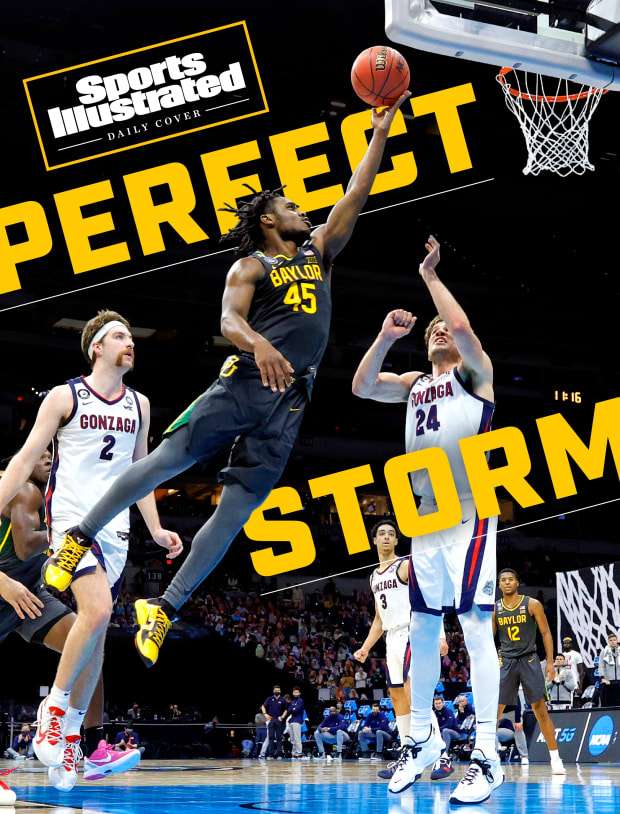
In a Big Dance with a record number of upsets, and two days after one of the greatest Final Four games in the event’s history, Baylor and Gonzaga served up a dud of a championship bout, not so befitting of a matchup between the top two seeds in the tournament. The Bears cruised, crushed and crumpled the Bulldogs, delivering one of the more dominant title-game performances of this era, an 86–70 thrashing sparked by an early outburst and sizzling longball shooting.
Coach Scott Drew’s team jumped out to a 15-point lead within eight minutes and altogether sank 10 three-pointers, capping one of the most unprecedented events in the history of NCAA sports—a unique and historic undertaking where, amid the COVID-19 pandemic, all 68 teams were sequestered across four hotels in downtown Indianapolis, playing at six different venues.
The final games were played here in Lucas Oil Stadium, a cavernous football structure that transformed into a pandemic-bubbled basketball arena, with mask restrictions, socially distant seating and limited capacity. At one-quarter full, Lucas Oil supplied a unique stage for a green-and-gold celebration, years, if not decades, in the making.
“I think it’s harder to win it this year than ever before, with the stoppages and testing,” said Baylor guard Jared Butler, the Final Four’s Most Outstanding Player and the Bears’ season-long star. “It’s cool we did that in the midst of tribulations and adversity.
“Everybody sacrificed for it. Everybody came back [for another year]. We got the band back together and we won it. Ought to make a movie out of it.”
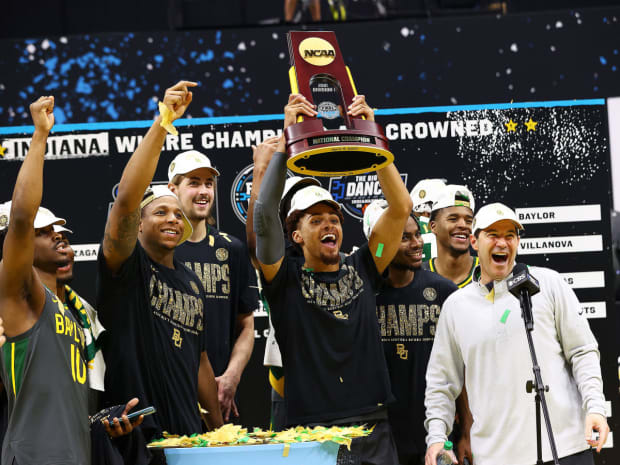
Baylor, a private Baptist college in the middle of Texas with a troubling history of past NCAA wrongdoing, stands atop the college sports world as a first-time men’s champion, having prevented Gonzaga from becoming basketball’s first undefeated men’s team since the 1975–76 Indiana Hoosiers. The postgame celebration, normally absent in a COVID-19 world, was fitting of a season’s worth of incredible accomplishments across a virus-impacted slate.
The Bears (28–2) had rebounded from a three-week pause in February for coronavirus protocols, claiming their first men’s conference championship since 1950 and then rounding into form late this season, resembling the beast that began the year 18–0.
On Monday night, Butler scored 22 points, fellow guard MaCio Teague added 19, big man Mark Vital grabbed 11 rebounds and the Bears forced Gonzaga into 14 turnovers while never letting their lead fall below nine points following the opening five minutes.
Such was the extent of the blowout that each team yanked its starters with 59 seconds left, preceding a celebration that lasted nearly an hour. On the court, confetti rained down; on TV, “One Shining Moment” made its long-awaited return after a two-year hiatus; and college basketball, through a pandemic and all, crowned a men’s champion.
Baylor’s players took turns climbing a nine-foot ladder to snip a piece of white nylon net, until their coach, Drew, cut the final strand and waved it toward the Bears’ crowd.
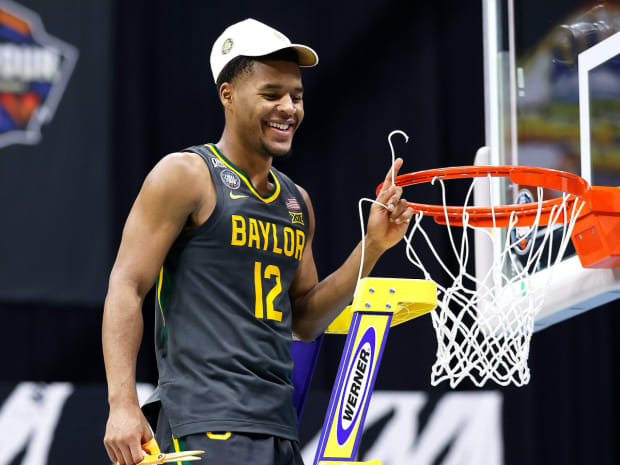
It was a relatively unique celebration—a faceless festival of masked partiers. Tears streamed down Drew’s cheeks, directly into his face covering. At one point, he yanked his mask down to scream toward the heavens, before quickly replacing it. NCAA officials, gloved and masked, brought to the court giant boxes full of championship hats and T-shirts, distributing the memorabilia across a confettied carpet.
In the stands, Bears fans—many of them players’ and coaches’ families, separated from their loved ones since the team left Waco for the Big 12 tournament on March 10—swayed and stomped, chanted and crooned.
“Excited to get in my own bed again,” Drew said. “It does make you appreciative of the money the university spent [for testing, etc.] and the players, what they sacrificed. Guys were breaking up with girlfriends at the beginning of the year to make sure they stayed in a bubble. They really sacrificed a lot.”
Together, they celebrated like first-timers would. But this could have been a repeat. Last March, Baylor was projected as a No. 1 seed before the NCAA canceled its tournament as the COVID-19 pandemic arrived in the U.S. One year later, at least three members of that Baylor team were in the Lucas Oil stands, rooting on ex-teammates to claim a prize many had predicted they themselves would have won.
“It was like a tornado hitting our town and destroying everything,” Butler says of last year’s cancellation. “We couldn’t understand it. We couldn’t fathom it.”
The 2020–21 Bears toppled the Zags (who entered 31–0) much in the same fashion they eviscerated their other victims this year: with a blazing display of long-range bombs. Monday’s start was a dream. Baylor leapt to a 16–4 lead less than six minutes in and made its first five threes, while the Zags were forced to bench their star, Jalen Suggs, who picked up his second foul three minutes into the affair. Altogether, it made for a stunning opening stanza that sent the largely partisan Baylor crowd (and gobsmacked fans at home) into a frenzy.
Bewildered and battered, Gonzaga stood like a doomed prized fighter wobbly circling the ring, discombobulated and dysfunctional. Eight minutes in, the Zags faced their largest deficit of the season, 15 points. Moments later, it was 35–16, an amazing firestorm of a start for a Baylor team that sizzled all season from the floor, entering the game as the nation’s leader in three-point shooting (.412).
During the opening blitzkrieg—up and down the court Baylor went, swishing shots, forcing turnovers and slamming the Zags—the Bears didn’t notice the score, Butler says. “I knew at some point we were up big. Everybody was hitting shots. It was electrifying.”
The 50-year-old Drew had assembled a group of sharpshooting guards—three of them transfers—that many in the college basketball world believe make up one of the best backcourts in the sport’s long history. They gave a rousing performance Monday night.
“Butler, [Davion] Mitchell, Teague, [Adam] Flagler, [Matthew] Mayer, I don’t think I’ve seen a team with five guards at that level, no drop-off,” Houston coach Kelvin Sampson had said after the Bears rolled his Cougars, 78–59, in the national semifinal here on Saturday.
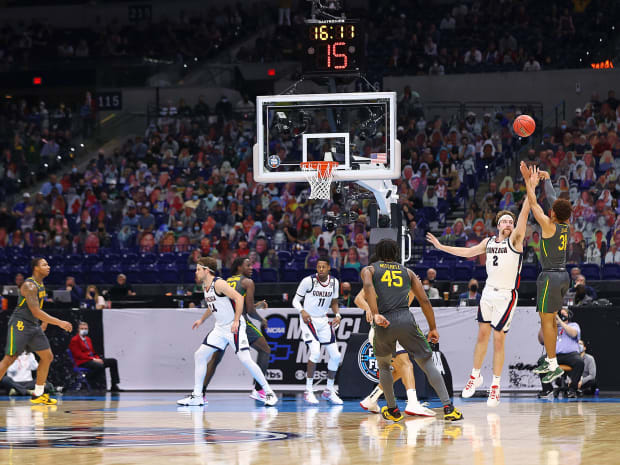
Flagler had transferred from tiny Presbyterian College (in South Carolina), Teague from UNC Asheville and Mitchell from Auburn. On Monday they combined for 47 points, including six threes, a blistering night from beyond the arc. (At one point in the second half, Baylor had made seven of 10 shots from beyond the arc that ESPN Stats & Info defined as contested.)
“We say all the time we’re the best guards in the nation,” Butler boasted as a snipped portion of the net dangled from his hat. “I think we proved that tonight. We made a statement.”
Despite COVID-19 restrictions, the crowd Monday night was boisterous and electric, swaying with every shot, a roller coaster of emotions. This wasn’t a cheap ticket. Even upper-deck seats were selling on the secondary market for $300 apiece, and spots within the lower bowl were going for more than $1,500. The matchup marked just the second time that two men’s teams each ranked in the top three all season long met for the national championship. (The only other such occurrence was in 1962, when Cincinnati beat Ohio State.)
And let there be no question: Gonzaga was a contender for the ages. The Bulldogs’ buzzer-beating, 93–90 overtime win over UCLA (a No. 11 seed) on Saturday night had ended a streak of 27 straight double-digit victories. The Bulldogs were the unquestioned top team in Indianapolis, poised to become the first men’s team in 45 years to finish with an unblemished record, led by the Final Four hero and future first-round NBA draft pick, Suggs, who banked in the now-famous three-point shot to send the Zags to the title game.
On Monday Suggs was pitted against the 6' 2", 205-pound Mitchell, Baylor’s lockdown defensive master who swept national Defensive Player of the Year awards this season. Twelve minutes into the game, Suggs had zero points and three turnovers. Mitchell, meanwhile, was electric from the start. He buried three of his first four jumpers and stole a pass during a furious first eight minutes. He finished with 15 points, six rebounds and five assists to deliver a rare men’s basketball title for Texas.
How rare? Baylor became only the second team from the Lone Star State to win it all, and the first since Texas Western (now UTEP), in 1966.
“It’s long overdue,” Drew said.

Much of the attention in the game’s aftermath centered on the coach. Drew celebrated his first title in his 18th year at the school—and he did it in the city where he attended college (at Butler) and the state where he worked for so many years under his father, former Valparaiso coach Homer Drew, who watched Monday from the stands. Scott Drew was only ushered into this job in the first place because of a scathing scandal in Waco that began with one teammate murdering another, and that ended with harsh NCAA sanctions.
In the summer of 2003, Baylor basketball player Patrick Dennehy’s remains were found near Waco, and later his own teammate, Carlton Dotson, pleaded guilty to murder. Dotson was sentenced to a 35-year prison term. (At his first parole hearing, in December, Dotson was denied, according to records from the Texas Department of Criminal Justice, and so: Just as the Bears got rolling, Dotson remained behind bars, at the John B. Connally prison unit, about 60 miles southeast of San Antonio.) In the weeks after the murder, the school and the NCAA began an investigation that revealed player drug use and improper payments to players by staff members. The NCAA hammered the program, eliminating a season of nonconference play and levying a 10-year show-cause penalty against head coach Dave Bliss, who resigned.
Drew took command of a program completely devastated, humiliated and lost, so destitute for talent that he held open tryouts within the general student population. The coach recalls starting games in the subsequent years just hoping that his Bears—often 30-plus-point underdogs—could keep the score within 20 points at halftime.
Drew’s tenure started with four consecutive losing seasons, just 21 total wins across his first three years. By 2008, though, Baylor hit the 20-win mark, and the Bears have never fallen below 18 wins since—an active 14-season streak that only three other programs (Kansas, Syracuse and BYU) can currently claim.
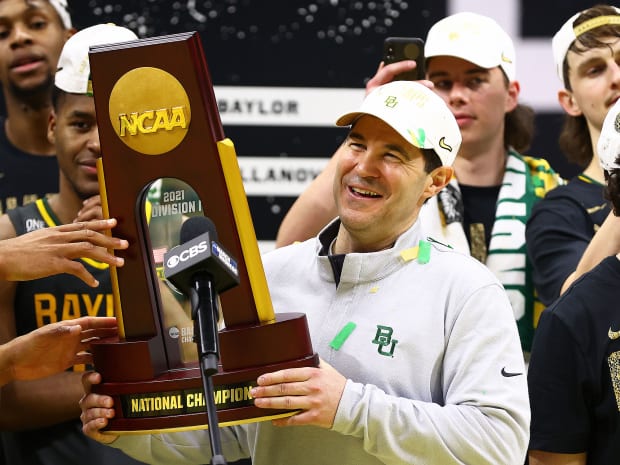
“Think about what he inherited,” says Baylor athletic director Mack Rhoades. “Who else in the country has done anything like that? What I’m most hopeful for is that people get to know and understand how good of a basketball coach he really is. People have known he’s a good recruiter and a player’s coach and those things, but the guy is as good with X’s and O’s as anyone in the country.”
Drew, now the youngest active men’s title-winning coach, has built a powerhouse in Waco, fueled by a recruiting machine that is crafted around his glowing personality and outward religious beliefs, both of which have, at times, made him a target for criticism.
“He has an optimism, a sense of faith and a sense of family and togetherness that is real,” ESPN analyst Fran Fraschilla told Sports Illustrated last year. “People said early on he’s a phony; he’s a charlatan. But the more you see it, you know it’s real stuff. He’s like that Sunday school preacher, but he believes what he’s preaching. Optimism, with him, is like breathing.”
Drew and the Bears show no signs of letting up. In fact, Baylor signed the highest-ranked recruiting class in program history (No. 4 nationally on ESPN) in November.
After Monday’s win, the coach celebrated by embracing players and staff, pointing toward his teary-eyed family in the stands. He’d taken Baylor’s men’s program to a place it hadn’t been since 1948, when the Bears lost in the title bout to Adolph Rupp’s Kentucky in Madison Square Garden. Seventy-three years later, they toppled the Zags to end an event that, surprisingly enough, did not include bluebloods such as the Wildcats themselves, nor Duke. Kansas and North Carolina, two more traditional titans, didn’t advance past the first weekend, and the tournament featured 14 upsets (as defined by the NCAA—a game involving teams with a seeding gap of at least five spots).
Besides title rings and a trophy, the Bears get another prize: a release from the NCAA’s invisible bubble, where they’ve been isolated since arriving on March 15.
Inside, players and staff found creative ways to occupy themselves. Gonzaga created a makeshift pickleball court inside its hotel. In fact, Bulldogs coach Mark Few says he and Drew were pickleball teammates. The two coaches, both big outdoorsmen, grew close; Drew now suggests he’ll make a trip to the Pacific Northwest in the offseason to visit his good buddy.
In the bubble, the Bears crafted their own basketball court. White tape, stuck to a carpeted ballroom floor, marked the boundaries and a full-sized basketball goal leaned against a hotel wall.
“After 30 days in the bubble, you start to not want to be around each other,” Butler acknowledged afterward. “Around dudes all day. I don’t know how we got through it.”
Baylor dealt with its own COVID-19 issues this season. In addition to missing those three weeks and canceling two conference games in February, the program had pulled out of the season-opening Empire Classic, in November, after Drew tested positive. Following the winter pause, in their second game back, the Bears lost for the first time this season, at Kansas. Drew’s team played sluggish down the stretch, especially struggling on defense, certainly not like the squad that had won every game between Nov. 28 and Feb. 23.
Here in Indianapolis, though, the Bears blasted through their bracket. They won every game by at least nine, for a combined total margin of 92 points—the fifth-highest all-time.
Says Drew: “We were on a mission.”
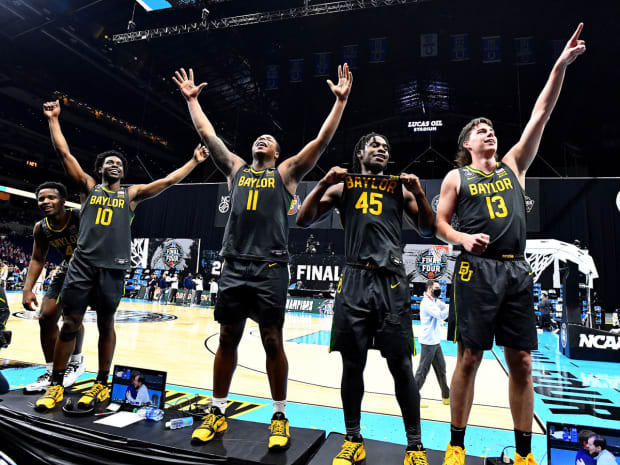
His team opened the event with a 79–55 win over No. 16 seed Hartford that was never close. Baylor cruised past Wisconsin, thanks to 17 bench points from Mayer, and in the Sweet 16 was briefly tested by Villanova, scoring just 23 first-half points and trailing at halftime before finishing the game on a 21–10 run. The Bears punched their ticket to the Final Four by using a 13–2 start to beat Arkansas, 81–72, and romped past No. 2 seed Houston with an incredible display of long-range shooting.
Baylor did it all with an unselfish approach. In Saturday's semifinal rout, its 23 assists were the most by a team in the men’s Final Four since UNLV’s 24 in a 103–73 championship-game win over Duke in 1990. The Bears’ six tournament games featured four different leading scorers.
This team is a hodgepodge, assembled from both the transfer market and the high school ranks. It is carried by that dynamic backcourt and anchored by an athletic frontcourt, too. Overshadowed somewhat by the shooting guards, the big men muscled their way into the spotlight on Monday. There’s 245-pound Flo Thamba, originally from the Democratic Republic of Congo; Cameroon native Jonathan Tchamwa Tchatchoua; and Vital, from Lake Charles, La., who was ruthless on the boards. He had eight offensive rebounds—three more than the Zags had as a team—and he finished the night by wiping tears from his eyes with his new championship T-shirt.
In Waco, the men’s program can finally claim a prize that its women have won three times since 2005. Coach Kim Mulkey—whose Lady Bears ran the NCAA tournament in ’05, ’12 and ’19—has built one of the top powers in the women’s game’s, having advanced to 10 Elite Eights in 16 years, including a trip to the regional finals last week that ended in a loss to UConn in a classic back-and-forth battle in San Antonio.
“They were the best team in the country all year, and they proved it in the championship game,” Mulkey said Monday night.
Finally—yes, finally—Drew and his team, more than a year late and 18 years after a devastating scandal, can stand atop the men’s college basketball world.
Finally, it happened.